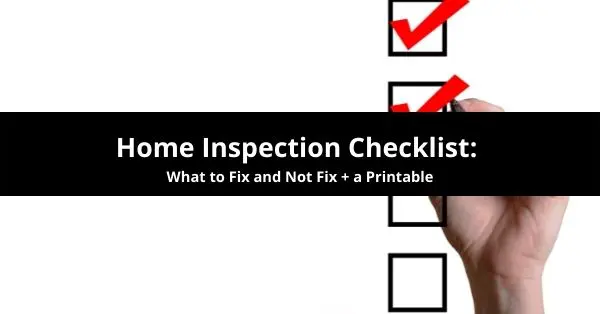While home inspections are not legally required in the home buying or selling process, many buyers will request them after making an offer on your home to verify that your house is in good condition. And if the buyer is taking a mortgage, almost every lender will require a home inspection for the same reason.
But home inspections are nothing to worry about. Even if some items fail, chances are they won’t be deal breakers, so if you’re a seller don’t stress and if you’re a home buyer, don’t panic just because something fails inspection.
With that said, it is still important to be prepared for the inspector. That is why we created this helpful home inspection checklist for you to use whether you are buying or selling a home. You can use this before your first open house, or download and bring the printable version as your shop for a new home.
Click here to download and print the home inspection checklist below:
- Fix or replace damaged flooring like torn linoleum or cracked tiles
- Drains, faucets, or plumbing fixtures should all have water pressure and drain
- Fill and paint any cracks or holes in the walls.
- Paint the interior with a fresh coat of paint
- Replace burned-out bulbs. A buyer or home inspector won’t know if a burned-out light is due to the bulb or an electrical problem.
- Fix any broken stairs inside or outside for both safety and aesthetics.
- Test your interior doors to make sure they close and latch properly
- If your garage door opener or sensors don’t work, repair or replace them.
- Check for cracked windows and torn screens and replace them. Also, if you see moisture coming in between the panes of your window, that’s a sign they need to be replaced.
- Look for cracks in your driveway and entry walkway to fix. Also, clean up any stains you see. Note: If a major repair is needed, you may want to offer the buyer a credit for the work.
- Paint the exterior with a fresh coat of paint.
- Touch up any peeling paint on window frames, porches, and shutters.
- Replace broken gutters and missing downspouts. Make sure they are cleaned out too for good drainage.
- Reseal your deck (to spruce it up) and repair any broken boards for safety.
- Look for missing shingles or damage to the flashing and fascia. This could be a sign that your roof needs to be replaced.
- Get your HVAC system cleaned and serviced.
- Check for proper drainage around your home, so there is no standing water after it rains.
- Make sure there is 12 inches of space between any vegetation and your house.
- Test your exterior locks and deadbolts to make sure they are latching.
- Make sure that the breakers in the electrical panel box are all labeled correctly.
- Check that all the outlets within six feet of your sink are GFCI.
- Verify that the batteries in your smoke and carbon monoxide detectors work. Be sure to replace the batteries every 6 months.
After going through the checklist above, it’s time to decide what to fix and what to leave alone.
Ask yourself these questions:
- What is the cost of the repair?
- Should I make the repair if the value of my house does not go up?
- Is the repair going to be a deal breaker for the average buyer?
- Will fixing the item open more issues, so it is better left to fail?
- Am I able to fix the problem myself?
- Are other similar homes for sale going to fail as well?
Your answers will help you make the right decision for your situation. There are some fixes you can take on yourself like filling holes in the walls, tightening cabinet doors, and repainting. However, there are items not to fix when selling your house because of the price tag, or fixing the item won’t add value to your house or cause a buyer to go elsewhere.
Here are a few of the larger repairs that can show up on a home inspection report, but are normally to costly to fix before selling:
- Updating the electric (up to $12,000)
- Mold removal (up to $6,000)
- Lead paint removal (up to $30,000)
- Replacing the HVAC system (up to $10,000)
- Roof replacement (up to $11,000)
- Major foundation repairs (up to $7,000)
- Infestation (up to $8,000)
If any of these repairs are a deal breaker for the buyer, you still have options.
You can:
- Negotiate the sale price.
- Lower the sales price to cover the cost of the repairs and the buyer can fix the issues after closing.
- Add in additional items that will make the buyer’s life easier when moving in like appliances that are the same value as the fix and TV mounts.
- Sell your house for cash to a real estate investor since they don’t always need inspections or care about fixes.
- Make the repairs and eat the costs from the final profit of selling your home.
Now you’re ready for your home inspection. You know what to fix, what to ignore, and most importantly to stay calm if the inspector finds problems. Most houses will have some problems, and not everything has to pass inspection. It won’t be a deal breaker. Even if it is, you still have options.


